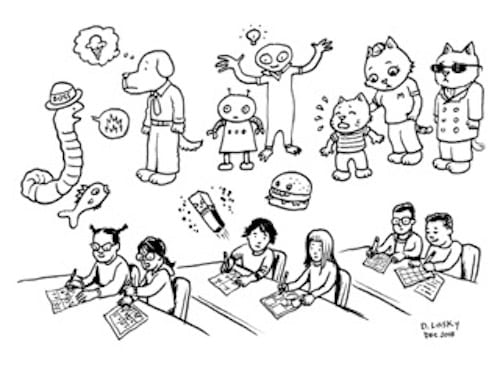
WITS Voices: Stories in Progress
January 3, 2019
By David Lasky, WITS Writer-in-Residence
The fourth graders in Mrs. Kahn’s and Mr. Moreno’s classes at Lowell Elementary are learning one of the most important, most vital skills practiced by humankind: the writing of fiction. Without the ability to imagine, possibilities in life become limited. And without the ability to work through fictional problems, real life problems can seem all the more insurmountable. I currently have the honor of visiting these two classes, in the heart of Seattle’s Capitol Hill, as a writer with the Writers in the Schools program.
I am augmenting their development as writers of fiction but am teaching from my area of expertise: as a graphic novelist. At the start of every session, I remind them that we’ll be writing with pictures as well as with words. Starting out, I worked toward helping everyone feel comfortable drawing very basic characters. A great graphic novel could star a grape wearing a cowboy hat (why not?), or a sentient apple, just as easily as it could feature something more complex, like a panda wearing a superhero cape and a birthday hat (the latter being a creation of Mr. Moreno’s class). After everyone had designed at least one original character, I provided some tools for telling stories with pictures, and they jumped into creating a short story in six or more comics panels.
Right now, the students are in the middle of creating their own single-page stories that will be collected in a class comic book. It’s been exciting for me to see what they’re working on, and I thought I’d share ten brief descriptions of their works-in-progress:
A dog who is fired from an office job by his boss (a worm wearing a hat that says: “Boss”) and uses this setback to pursue his dream of opening an ice cream shop.
A master thief attempts to rob an entire shopping mall, and succeeds.
A French fry who becomes a superhero, complete with shiny red armor. His arch nemesis: a hamburger. (They have a history.)
A boy who runs toward the horizon, determined to break a rainbow, because he wants colors to be free for everyone. After running a great distance, he crashes into it, and wakes up lying on the ground with colored lollipops raining down all around him.
A cat who tries out a variety of careers, and does not like any of them, until she lands a job with Meow-Donald’s.
A son who decides to steal his father’s money, while his father is asleep on the couch, and is caught.
Two teens, who are a couple, communicate by text messages, even though they are standing right next to each other.
A fish who is bullied in school but defended by its brothers.
A robot whose factory is blown up by a bomb, who then rides in a sentient robotic truck to find a new factory to call home.
A wealthy man whose apartment building burns down, forcing him to look for a job.
For many of the students, this is their first time drawing a story. It’s exciting to see the breakthroughs they’re making. A student might tell me that they “can’t draw,” and the following week draw sketches of the characters they’d dreamed up, constructing them from basic shapes. The week after that they might surprise even themselves by drawing a short comic, complete with facial expressions and backgrounds. Students’ faces light up at this point, because they’ve just learned to communicate using a language that has been with us longer than any alphabet.

David Lasky is the co-author of the Eisner-Award-winning graphic novel, Carter Family: Don’t Forget This Song, but he is better known to children as the guy who colored Cece Bell’s awesome graphic novel, El Deafo, a Newbery Honor Book. He teaches comics at numerous venues in the Seattle area, including Hugo House and Coyote Central.